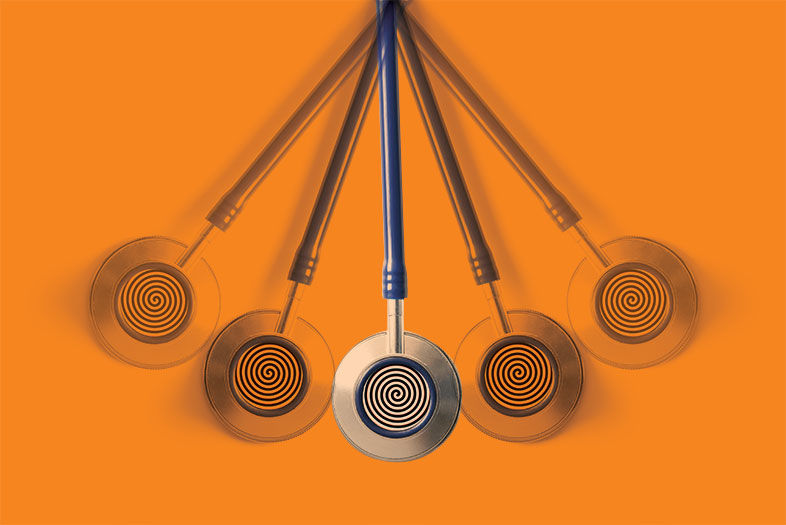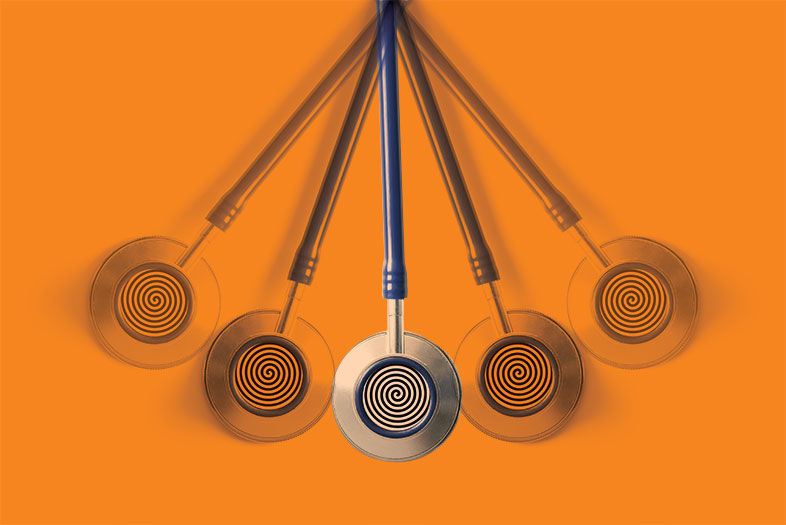You Try It!
Center Point Medicine
3252 Holiday Court, La Jolla
858-201-4001
I am a nail biter. It’s a terrible and gross habit. I have always wanted to be one of those polished women with long fingernails lacquered in a chic, fashion-forward color. But after 36 years of fully committed nail chewing—to the point of peeling cuticles and occasional bleeding—it feels like I am destined to have scraggly stubs forever.
Enter Dr. Ran Anbar, who claims he can help reduce, and in some cases cure, just about any bad habit and even some illnesses with an unusual tool: hypnosis.
The idea of hypnotherapy is often misunderstood, conjuring images of a swinging pendant and spinning wheel (you are getting sleepy…), or that entertainer at the county fair who puts audience members in a trance and makes them dance like monkeys. This is not that.
“All hypnosis is self-hypnosis,” Anbar says, noting that most of us have experienced hypnosis without realizing it. Everyday examples include daydreaming during a meeting (part of you is listening to your boss while part of you is writing your grocery list), playing pretend (a child really visualizes steaming tea in that plastic kettle), and driving home (when you suddenly arrive and think, How did I get here?).
Anbar’s practice is unique. He is a board-certified pediatrician and pediatric pulmonologist. He’s also a fellow of the American Society of Clinical Hypnosis, and over the last 17 years, has treated more than 4,000 patients with hypnotherapy and counseling. Today, he specifically works with children and adolescents, but all ages are welcome. (He’s currently counseling an octogenarian married couple.)
Anbar first became interested in hypnosis when, as a pediatric pulmonologist, he discovered a link between the physical and mental effects of asthma. When children can’t breathe, they typically panic, and their breathing quickens. The tendency for most doctors is to prescribe a higher dose of medication, but Anbar learned that by teaching patients simple hypnosis techniques, in most cases they could control their breathing on their own.
This same principle can be applied to many illnesses and symptoms. “I think most people are aware, in the 21st century, that the mind affects the body,” he says, citing stomachaches or headaches from stress as examples of the mind-body connection. “The real question is what you can do to direct it in a positive way.”
I spent two hour-long sessions with Anbar, who quickly assessed that my nail biting was the result of chronic anxiety and worry. (I’m pretty sure I had my fingers in my mouth while he was telling me this.) He taught me the basics of hypnotherapy, which entail sitting in a calm state with your eyes closed, imagining a worry-free place, and engaging all five senses (what are you seeing, hearing, smelling, touching, and even tasting).
He directs you to relax every part of your body from head to toe. Then you go back to your happy place and begin to talk to your subconscious, saying things like: I feel really good right now, I’d like to continue feeling this way for the rest of the day, I am not going to worry about XYZ, everything will work out soon, and so on.
In meditation, the goal is to quiet your mind, which is really hard to do. In hypnosis, your mind is busy doing calming activities.
Sure, this seems a little hokey, but Anbar says the power of positive thoughts and the specific words we use to talk to ourselves can be life changing. For example, I learned that “try” is a very negative word and leaves room for failure. I will try to be better; I will try to XYZ. So instead, I now say, I’m working on it, whatever “it” may be. And supposedly, the more you practice, your subconscious can reveal unexpected things, like a worry or fear that might be buried in the back of your mind.
Anbar also taught me to make a gesture, like a loose fist, while in my happy place. You’re meant to make the same gesture every time, and with practice, that gesture will become an instant cue for your body and mind to relax. Stressed out in bumper-to-bumper traffic? Make a fist. Happy place. Having an asthma attack? Make a fist. Catch your breath.
The whole process feels very close to meditation, and when I asked Anbar about this, he explained that meditation is a much more focused form of hypnosis. In meditation, the goal is to quiet your mind, which is really hard to do. In hypnosis, your mind is busy doing calming activities. You also don’t have to do hypnosis as long; you can get a result in two minutes.
I can see why this would work really well for children, who tend to be less guarded and skeptical. Indeed, Anbar says he has gotten amazing results with patients in as few as one or two sessions. “You need to be open to it,” he explains. “People say if you’re a believer it must not be real. But belief makes your reality. The great athletes believe they can make the next shot. That’s what makes them great.”
For the sake of writing this story, I committed to practicing my hypnosis every day for two weeks, specifically before I sat down to write anything. I think I actually did it six times (okay, four). I spent a lot of time worrying about the fact that I didn’t have the time to practice. And then I spent even more time worrying about that.
But when I did use Anbar’s techniques and allowed myself to drift off to my happy place, I did feel more relaxed and focused. On several occasions I felt my anxieties flare suddenly. So I made my fist, and it helped. I also became hyper-aware of how often I use the word “try,” and have made a conscious effort to be more positive and present.
As for the nail biting, I must be honest and admit that I’ve pulled my fingers from the clutches of my front teeth at least a dozen times in the last hour alone. All I can say is, I’m working on it.










